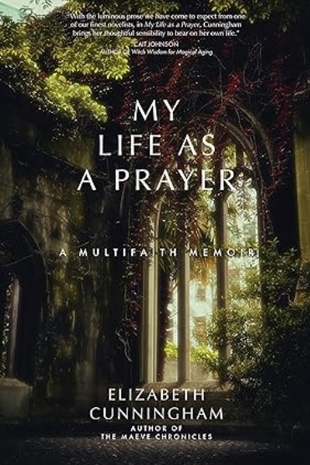Thousands of readers will know this author for her series of novels featuring a Celtic Mary Magdalen, The Maeve Chronicles. Elizabeth Cunningham is descended from generations of Episcopal priests, and she writes beautifully here of that heritage, of growing up next door to her church and also the woods she felt compelled to enter to discover more.
In the opening chapters, God, Cunningham’s father, and a certain Miss Schultze (“eccentric, exacting musician, organist and director of the adult and children’s choirs”) are written about with a mix of affection, fear, and wonder.
But the power of the woods keeps returning. “I would not have used these words then, but I knew: the wood was a holy place, one where God had no jurisdiction and neither did Jesus. The wood did not belong to people, though I would not have been surprised to glimpse a flash of tawny gold between the trees…. In the wood I was as an outlaw, free as Robin Hood, freer,” Cunningham explains.
She tells stories of her childhood, education, adolescence, then college and adulthood, becoming a writer, and wandering in many places of the Hudson Valley. Always the wandering of the mind is equal in importance to the movement of her feet.
This is a memoir for people of faith and no faith, for anyone who wrestles with the sacred or divine. Cunningham prompts the reader to think for themselves.
For example, referring to an episode in the Gospel of Matthew (chapter 21) in which Jesus curses a fig tree that then withers and dies, Cunningham reflects: “Maeve (my Celtic Magdalen) … restored the fig tree that Jesus blasted, gathered up the miraculously ripened fruit and pelted him with figs in the Temple porticoes.” She then acknowledges how some people interpret the gospel fig tree story as symbolic, that Jesus did not really kill a tree, but it doesn’t matter. “We should consider that figs are associated with female genitalia. So of course Maeve objected to the blasting of the fig tree (or, druid-trained as she was, any tree). Maeve’s bombarding of Jesus with the figs remains for me an exhilarating, fictional ‘fuck you.’ For my theology, such as it is, includes calling out God’s beloved son, too, whom I love — Jesus, that is, not his father.”
Just beyond the book’s mid-point, we follow Cunningham into The New Seminary in New York City where she is eventually ordained an interfaith minister. Her life then takes a turn toward what solitary monks and nuns would call a hermitage, a life in which she says, “I hear cautioning whispers” from saints and rascals of times gone by. She practices prayer, listening, and wonder. “Many, though not all, of my conversations are with Jesus, as I know him,” she explains at one point.
At another: “I can see and feel … a Presence strong and golden, not human yet knowing of the human, compassionate, not form yet not void.”
Provocatively, Cunningham asks, in a way that feels relevant for every person who understands life as a spiritual quest, “What do I actually do? I listen to people. I listen for stories. I write and rewrite sentences. I notice beauty. Could that possibly be enough? Whether it is or isn’t, that’s what I do amidst all I don’t do. That is where doing slips over some edge (a waterfall, a rocky precipice) into being.”
Go Deeper:
Walking on Sacred Earth: An E-Course on awakening to intimacy with the natural world.
